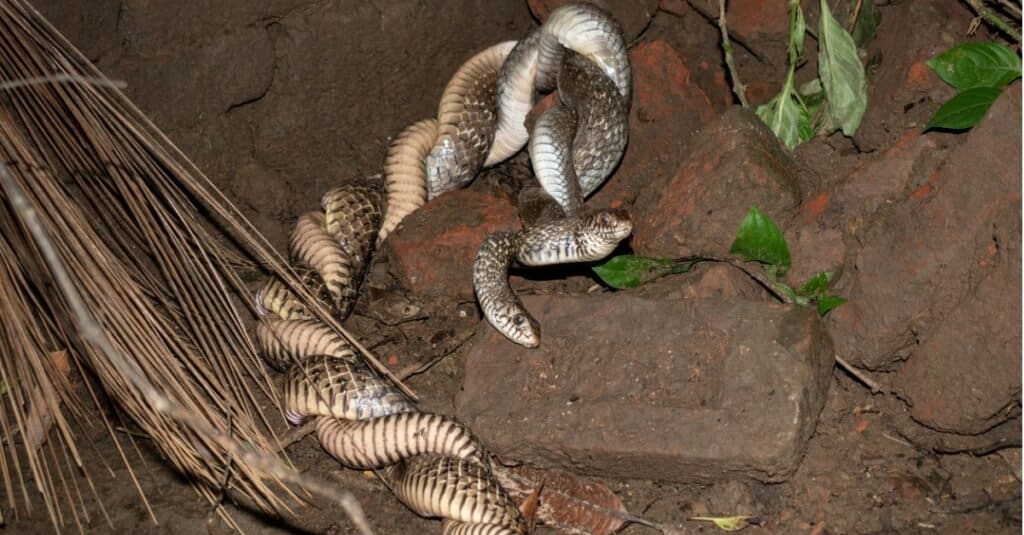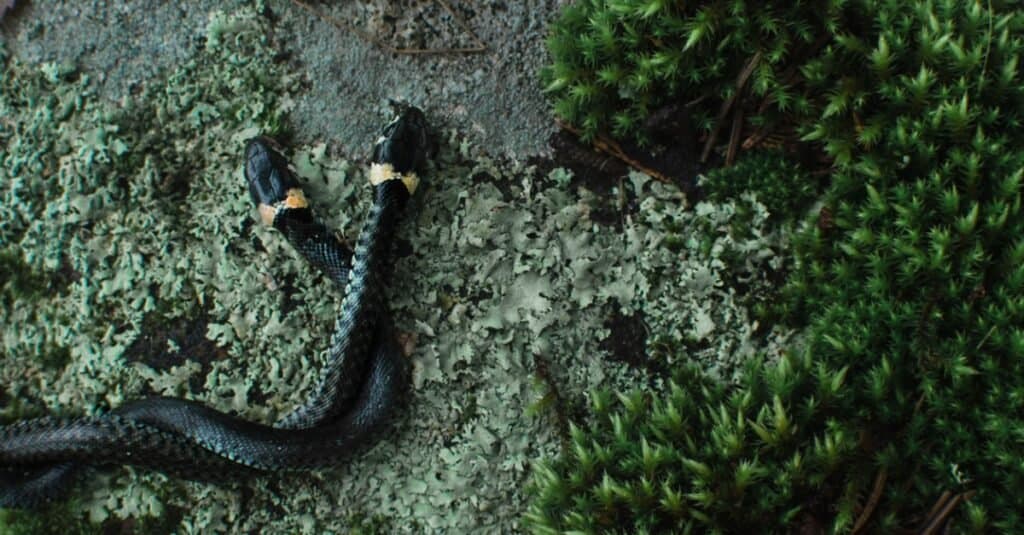Love them or hate them, snakes always seem to engender strong feelings. It makes sense given all the history, mythology, secrecy and speculation surrounding the lives of snakes. A little bit of curiosity about how these inscrutable creatures reproduce is only natural. And if you’re here, that very question “How do snakes mate?” is most likely on your mind. When it comes to snake reproduction, the facts are almost as interesting and confusing as some of the fiction.
Reproduction is at the cornerstone of all life, and the impact of the environment and circumstances can lead to the development of some truly unusual differences in how organisms reproduce. There are more than 4,000 snake species on the planet. And while we can recognize the process of mating among snakes is generally not that different than the practices of most animals, there’s a surprisingly wide gap in our biological understanding of a snake’s courtship, breeding, and reproductive practices. That’s in large part thanks to the secrecy and inscrutability of these animals. It wasn’t until 2010 that it scientists discovered some snakes can breed asexually, and mating rituals among snakes can vary wildly considering the breadth of species and the scale of environments they inhabit. However, we do know quite a bit about how snakes mate, and that knowledge can help to make these cold-blooded predators seem less alien.
Mating Season For Snakes

Many species of snake breed in a ball often known as a mating knot.
©iStock.com/DEVJYOTI BANERJEE
When mating season happens for a snake species it appears to be almost entirely contingent on the climate of their ecosystem. In areas with a conventional year constructed of four distinct seasons, snakes will feel the urge to breed in spring. This is often just after they wake up from brumation — the reptilian equivalent of hibernation, which usually takes place through the winter. It’s natural for mating to peak as the sunlight comes out and provides more energy to snakes, but it makes sense for inter-generational survival, as it allows snakelets to be born in the summer when food and sunlight are most readily available.
In regions with more complicated climate patterns, there may be multiple mating seasons — and in tropical, and some subtropical regions, mating can happen throughout the year instead of a traditional mating season. No matter what part of the world a snake is born in, mating habits have adapted to ensure one critical thing above all else: that the young can develop enough to properly survive the cold season. Of course, practical needs always prevail. Both male and female prairie rattlesnakes in Wyoming are solitary and forage for themselves, but males have consistently proven to be more effective at employing efficient hunting methods. That allows them to spend the latter part of the season focusing less on foraging for their food and more on seeking out a mate.
The Courtship Rituals of Snakes
So how do snakes mate? Considering their lack of limbs and blankly emotionless features, it can be hard to imagine what snake mating dances might look like apart from a lot of slithering. The fact is that mating courtship is common among snakes, but both the process of recording mating and the act of interpreting it can be difficult. Despite this, there’s a growing body of research regarding the courtship rituals of various snake species and the recurring factors between them. This includes patterns that suggest that the behaviors for territorial fights between males and mating rituals adopted alongside one another. Snake breeding is not rough by nature, but the various movements and undulations seem to have developed in tandem and influenced one another.
There are clear behaviors that most snakes developed to differentiate the body language of hostility from a mating proposal. Fighting males of most species will lift their heads to fight but not when they’re looking to proposition a mate. Territoriality over mates is common among snakes but not always bloody. Rattlesnakes will fight without their fangs in what amounts to a wrestling match when pursuing the same mating partner. Studies into viper mating rituals are comprehensive enough that researchers can identify a whole range of courtship gestures largely shared between this family. Various forms of nibbling, undulating, and caressing have been identified among most vipers. It’s a body of knowledge sophisticated enough that they can even recognize uniquely speciated behaviors. This is the case with the short-tailed viper, where females have been identified quivering as part of their vocabulary of courtship gestures.
Mating Between Snakes
Many species of snake breed in a ball often known as a mating knot. This is a tactic employed by the common garter snake, which is one of the most populous snakes throughout the United States and Canada. When female garter snakes awaken from brumation in the spring, they do so a few days behind males. That extra time allows the males to get in peak condition for a fierce battle to procreate. When female garter snakes arrive in the light, they find themselves overwhelmed by a mass of aggressive and amorous snakes all trying to breed with her. It’s more than simply a matter of who gets there first.
Both female and male snakes have a single hole called a cloaca which contains their reproductive organs and serves as the endpoint for their digestive and urinary systems. The goal of the males is to get access to the female’s cloaca for breeding, but she generally has more control over the situation than the free-for-all appearance lets on. Females can choose to open or close their cloaca, so while males scramble on her in a ball, she gets to decide who in the mating knot to breed with. Of course, how well male snake fares against other males in the mating knot can have a dramatic effect on whether or not he can even get close enough to breed.
Green pythons are another species known to mate by forming a mating knot, demonstrating that size and danger aren’t an impediment towards this mating methodology. There’s some evidence to suggest that this form of group mating is an adaptation developed primarily in ecosystems with shorter seasons of warmth and sunlight. Maximum competition between mates in as short a period only increases the viability of young surviving longer.
Not all snakes breed in a ball, though these reptiles certainly aren’t monogamous breeders that mate for life. Females of species that don’t form mating knots still give off pheromones that attract males, but the first to reach her will often engage in non-lethal combat to prove their value as a mate. This seems to be more common in ecosystems where there are fewer time restrictions for a viable mating season and where snake populations tend to be lower or more widely dispersed. For the most part, snake species tend to primarily engage in polygyny — where males have multiple partners and females typically have one.
The male reproductive organs of a snake include two penises. Each has its separate reservoir of sperm. This allows them to mate successfully with two females in a short period. Male reproductive organs are otherwise kept hidden within the cloaca and emerge in the open only for mating. The actual breeding process can take anywhere from an hour to a day depending on the species, though the male leaves and does not continue to have a part to play in the hatching of eggs or raising of young.
Sexual Reproduction Among Snakes

©iStock.com/Ilse_Innire
While a majority of snakes lay eggs which then hatch into baby snakes, about three in ten species give birth to live young. Eggs aren’t viable in the water, so partly aquatic snakes that lay eggs retreat to land to lay their eggs in a nest. Sand and grass are common sites for nests, and mothers may make an effort to cover up their eggs — a decision that can help protect them from predators and keep them warm enough to properly incubate. Even most sea snakes — which live in the water and breed in the water — slither onto land at least long enough to give birth.
Parenting responsibilities can vary wildly between species. While it was once believed that no species of the snake had parental instincts, it’s now known that python mothers care for their young for weeks after giving live birth. And they do so at great personal cost. Mother pythons don’t eat anything during their pregnancy and can lose up to 40% of their body weight during this time. That alone can be fatal.
Asexual Reproduction in Snakes
The first proof that snakes can reproduce asexually emerged in 2010 when a female boa constrictor was observed using her DNA to fertilize her eggs without the need for male reproductive organs. Snakes aren’t the only animals to reproduce asexually either. Sharks are also known to have the capacity to reproduce asexually, and the list of snake species capable of these “virgin births” is growing longer.
We now know that species of a copperhead, pit viper, water snake, and cottonmouth are all able to reproduce asexually. In most species, this behavior is a rare alternative to sexual reproduction that’s normally only seen when there’s a scarcity of potential mates. The Brahminy blind snake is the one exception. Found throughout Asia and Africa, all members of this species are females who simply lay and fertilize eggs every breeding season as a matter of course.
Up Next…
- Brumation vs Hibernation: What Are the Differences? Have you ever wondered what snakes do in the winter? Do they hibernate? Not quite. Find out the real answer here.
- Snake There are thousands of species of snakes. Learn more about snakes in this article.
- Corn Snake These are one of the most popular pet snakes. If you are thinking about a slithery friend, check out these guys.
The photo featured at the top of this post is © iStock.com/vlad_karavaev
Discover the "Monster" Snake 5X Bigger than an Anaconda
Every day A-Z Animals sends out some of the most incredible facts in the world from our free newsletter. Want to discover the 10 most beautiful snakes in the world, a "snake island" where you're never more than 3 feet from danger, or a "monster" snake 5X larger than an anaconda? Then sign up right now and you'll start receiving our daily newsletter absolutely free.
Thank you for reading! Have some feedback for us? Contact the AZ Animals editorial team.






